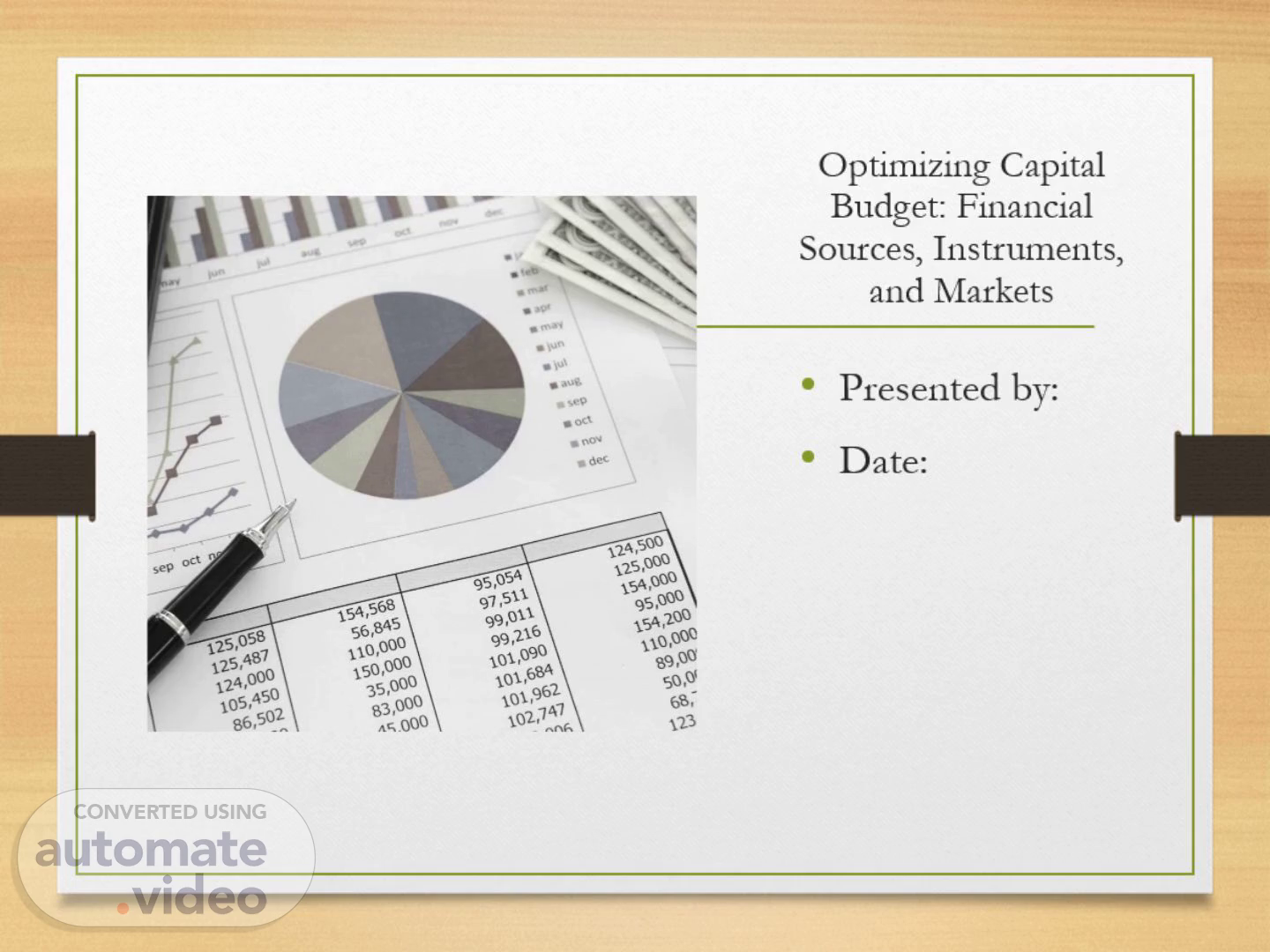
Optimizing Capital Budget: Financial Sources, Instruments, and Markets
Scene 1 (0s)
Optimizing Capital Budget: Financial Sources, Instruments, and Markets.
Scene 2 (11s)
[Audio] Companies must strategically balance financial sources and uses to achieve optimal outcomes, ensuring projects align with corporate goals. They do this by using structured processes to identify financial sources, allocate resources, and optimize their capital budgets. This process ensures strategic investment, balancing risk and profitability. The importance of this process lies in its ability to help managers make informed decisions, ultimately maximizing shareholder value..
Scene 3 (43s)
[Audio] Financial sources refer to the means by which a company raises funds to finance its operations and projects. These sources include equity, debt, and retained earnings. The effective allocation of these sources to uses such as investments and acquisitions is crucial for achieving financial efficiency and sustainability..
Scene 4 (1m 2s)
[Audio] The payback period is a measure of how quickly an investment recovers its initial cost. This metric is simple to calculate, using the formula of dividing the initial investment by the annual cash inflow. However, it has limitations, as it does not take into account the time value of money or long-term returns. Despite this, the payback period remains a useful tool for evaluating investments, particularly when considering liquidity..
Scene 5 (1m 30s)
[Audio] The Net Present Value, or NPV, is a crucial tool in evaluating the profitability of an investment. By considering the present value of cash inflows minus cash outflows, it provides a clear indication of whether a project adds value to the company. A positive NPV signals that the project is profitable, while a negative NPV suggests that it's better to avoid it. This metric takes into account the time value of money, making it a powerful tool for businesses looking to maximize their returns..
Scene 6 (2m 1s)
[Audio] The Internal Rate of Return, also known as the IRR, is a crucial tool in evaluating the feasibility of a project. It's the discount rate that makes the net present value of a project equal to zero. This means that if we calculate the IRR of a project and it's higher than our company's weighted average cost of capital, or WACC, then we should accept the project. On the other hand, if the IRR is lower than the WACC, we should reject the project. The IRR provides an intuitive benchmark for assessing the profitability of a project, making it easier for managers to compare different investment opportunities. However, it's essential to note that the IRR can sometimes lead to conflicting results when comparing mutually exclusive projects. Nonetheless, it remains a valuable tool in the capital budgeting process..
Scene 7 (2m 51s)
[Audio] A company's capital structure refers to its combination of debt and equity financing. A well-balanced structure allows a company to minimize its costs while maintaining financial flexibility and reducing the risks associated with over-leveraging. The significance of a balanced capital structure lies in its ability to balance the cost of capital and financial risk..
Scene 8 (3m 11s)
[Audio] The Weighted Average Cost of Capital, also known as WACC, is a crucial concept in capital budgeting. It represents the average rate of return required by both equity and debt holders. In other words, it's the cost of funds that a company needs to raise from various sources to finance its operations and projects. This rate is used as a discount rate to evaluate the profitability of potential projects, helping businesses decide whether to invest in them or not. The formula for calculating WACC is straightforward: it's a weighted average of the cost of equity and debt, taking into account the proportion of each source in the company's capital structure. The significance of WACC lies in its ability to reflect the company's overall cost of funds, providing valuable insights for investors and stakeholders alike..
Scene 9 (3m 59s)
[Audio] Companies should strive for an optimal capital structure that harmoniously blends debt and equity to reduce the Weighted Average Cost of Capital (WACC) and increase firm value. This ideal combination considers multiple factors, such as tax advantages, market circumstances, and industry standards. By weighing these elements, businesses can find a balance between the expense of capital and financial risk, enabling them to make more informed investment choices..
Scene 10 (4m 27s)
[Audio] The interconnection between NPV, IRR, and WACC enables managers to assess investment prospects holistically. WACC functions as a yardstick for both NPV and IRR, implying that any project's NPV or IRR should be compared to its corresponding WACC to determine if it constitutes a viable investment opportunity. Moreover, a firm's capital structure influences its WACC, necessitating consideration of this aspect when examining potential investments. Additionally, payback period, NPV, and IRR all serve as guides for project evaluation, offering valuable insights into anticipated returns and risks associated with each investment prospect. By integrating these factors, managers can make informed choices regarding which projects to pursue, ultimately fostering growth and maximizing shareholder value..
Scene 11 (5m 15s)
[Audio] Companies need to adopt a strategic approach when optimizing their capital budget. This involves understanding the various financial sources available, including markets and tools such as NPV, IRR, and WACC. By doing so, companies can make more informed decisions about where to invest their resources, ultimately driving growth and minimizing risks while maximizing shareholder value.
Scene 12 (5m 40s)
[Audio] The references listed here have been carefully selected to ensure the accuracy and reliability of our analysis. The principles of corporate finance, as outlined by Brealey, Myers, and Allen, provide a solid foundation for our discussion. Additionally, Investopedia.com has been a valuable resource in compiling this information. We appreciate the opportunity to share these findings with you..